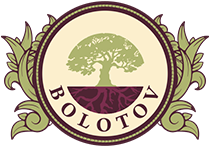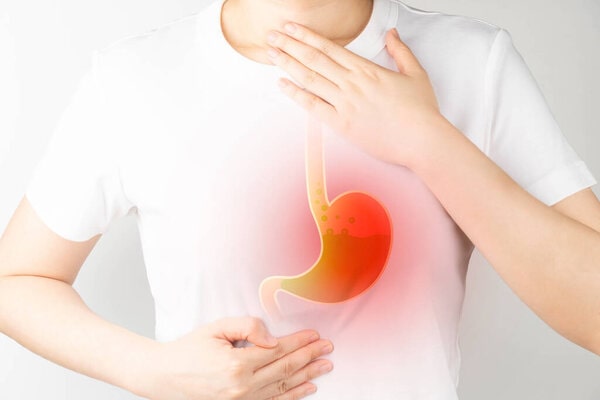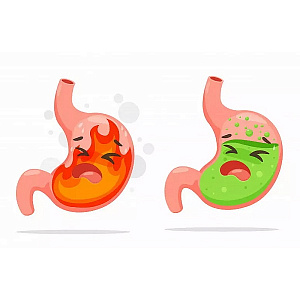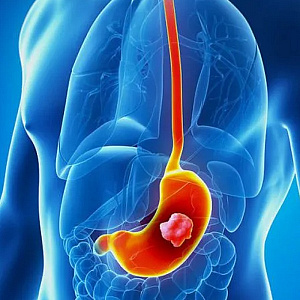GERD is a chronic disease caused by the GI tract dysfunction. It often occurs with relapses - periodic exacerbations. Pathology is manifested by a disorder of the motor-evacuation activity of the stomach and esophagus. The contents of the stomach, due to a malfunction of the esophageal sphincter located below, rises back into the esophagus. The reverse outflow of food is accompanied by severe pain, heartburn and discomfort.
The consequences of a longtime disease are a peptic ulcer of the esophageal mucosa, the development of Barrett's esophagus (a change in the structure of the epithelial lining of the esophagus at the cellular level) and adenocarcinoma (malignant neoplasm). The prevalence of GERD is about 30-60% of the population. Symptoms of the disease with a frequency of at least 1 time per week are detected in 20-30% of the population.
Reference information: Gastroesophageal reflux is characterized by esophageal sphincter disorder, which is located in the lower part of the canal at the junction with the stomach. The result of disorder valve device functions is the reflux of the stomach contents back into the esophagus.
GERD: provoking factors and causes
The disease develops as a consequence of a disorder of esophageal sphincter functions. Disorder occurs due to a decrease of sphincter muscle tone or repetitive spontaneous relaxation of the valve device, not connected with swallowing. The relaxation is often the result of pressure increase in stomach. Pressure increase is often connected with organ congestion or flatulence (increased gas formation).
Causes of GERD:
● Systematic violation of diet.
● Unfavorable ecological situation.
● Intoxication, chemical impact on the body, including drug components.
● Infectious lesions.
Factors that increase the risk of developing the disease include obesity, frequent fatty food consumption containing caffeine and carbonated drinks, smoking and alcohol overuse. Provoking factors include metabolic syndrome (obesity, increased concentrations of glucose and cholesterol in blood).
Reference information: An increased level of visceral sensitivity (response to esophagus distension during the reverse flow of stomach contents, as well as to the influence of chemical elements from food and reflux) causes the appearance of characteristic symptoms in patients with non-erosive GERD.
Often, GERD develops due to systematic use of pharmaceuticals prescribed for the treatment of another pathology. The group of pharmaceutical drugs that lower the muscle tone of the esophageal sphincter includes:
● Anticholinergics (block the action of acetylcholine).
● Antihistamines (block histamine receptors).
● Antidepressants of the tricyclic type.
● Calcium channel blockers.
● Progesterone (reduces the contractility of smooth muscles).
Pathology progression is promoted by factors such as the caustic composition of refluxate (a substance moving in the opposite direction from the stomach into the esophagus), a decrease in the protective potential of the mucous membrane.
Gastroesophageal reflux disease: classification and forms
GERD is a heterogeneous disease. Different forms differ in manifestations and nature of the course, require an individual approach to the choice of a therapy program. For example, with a non-erosive form, the response to drug antisecretory treatment is less pronounced. Therefore, in addition to the drugs of the classical protocol, psychotropic drugs are prescribed.
Reference information: Today, there is no clear understanding of whether esophageal manifestations (non-erosive form of the disease, erosive esophagitis, Barrett's esophagus formation) are successive stages of the course. In some scientific sources, they are considered to be as separate forms of pathology with peculiarities of pathogenesis and clinical performance.
Gastroesophageal reflux: symptoms
The main symptom of the disease is heartburn, which is often accompanied by gastric contents ingestion into the oral cavity. GERD Symptoms in newborns include vomiting, irritability, and weight loss. A disease in a newborn child often causes chronic aspiration - involuntary suction of gastric contents into the respiratory tract. Aspiration is sometimes seen in adults. As a result of chronic aspiration, following symptoms appear - throatiness, hoarseness, cough, stridor (noisy, wheezing).
In 68% of patients, syndromes characteristic of laryngitis (labored breathing, nasality, weakness and lowering of the voice timbre, swallowing dysfunction) are detected. Extraesophageal signs of pathology include bronchial asthma and erosion (damage) of tooth enamel. Symptoms are often more pronounced in patients with central hypersensitivity connected with constant stress, chronic sleep deprivation, and a longterm course of general chronic diseases. In patients with central hypersensitivity, depression and increased anxiety are often present in the clinical picture.
GERD: diagnostic methods
The diagnosis is established on the basis of the clinical picture, anamnesis data and examination results. Diagnosis of GERD includes instrumental and laboratory methods. Usually in the complex of diagnostic procedures there is endoscopic examination (esophagogastroscopy), determination of the degree of gastric juice acidity (pH-metry). During endoscopic examination, tissue is taken (scraping, biopsy) for histological tests (study of the morphological structure of the tissue for mutated cells).
Gastroesophageal reflux: treatment methods
Complex therapy, according to clinical recommendations, includes changing lifestyle and diet, reducing the gastric juice acidity with the help of pharmaceuticals. Sometimes surgery is indicated. Clinical standards (protocols) provide for such regimen measures as raising the level of the head segment of the bed and correcting body weight (for overweight patients). The head of the bed is raised to 15 cm height.
GERD: surgical treatment
One of the options for surgical treatment is laparoscopic fundoplication. This is an operation to wrap the fundus of the stomach around the circumference of the esophagus to create an artificial cuff. The cuff prevents gastric contents penetration into the esophagus. The operation is performed in the presence of complications that threaten health and worsen the quality of life. Among the surgical intervention indications are internal bleeding, strictures (persistent reduction in canal lumen), hernia in diaphragmatic opening at the junction with the esophagus, recurrent ulcers in the mucosal zone. The operation is indicated for patients who have ineffective drug therapy or have contraindications for taking drugs. To treat strictures, the method of endoscopic dilatation (expansion) of the esophagus is used.
Gastroesophageal reflux: drug treatment
According to clinical protocols, GERD is treated with acid suppression therapy, which is aimed at reducing gastric juice acidity. Medicines for GERD are mainly tablets that reduce hydrochloric acid production (H2-histamine receptor blockers, proton pump inhibitors).
Drugs are usually used for a long time according to a scheme individually developed for each patient by the attending a doctor. The minimum dose to which the patient responds is experimentally selected (elimination of symptoms is achieved). In some cases, patients take medication episodically (as needed) or intermittently (short courses).
How to treat GERD at home: Bolotov’s method
Treatment of GERD according to Bolotov is an effective alternative to traditional drug therapy. If pills do not help, reflux treatment at home can be done using tried and tested methods.
Treatment of GERD according to Bolotov involves the regular intake of a unique author's balsam. The author of the recipe is the scientist Boris Bolotov, who has gained wide popularity and recognition thanks to the unique methods of healing and rejuvenating the body. Bolotov's unique methods are based on the results of his own research, folk recipes and the accumulated world scientific experience in the medical field. The composition of the balsam, patented in 2011, includes water, a fermented component from red grape varieties, grape vinegar, succinic acid and an acidic mineral-organic complex, nitroglycerin, additional ingredients (vitamin supplements, honey, lemon).
Bolotov balsam promotes the regeneration of damaged tissues and the restoration of the normal structure of the mucous membrane of the digestive tract. In addition to a beneficial effect on damaged tissues of the esophagus, the balsam gives other therapeutic effects:
● Normalizes the work of the cardiovascular system.
● Removes salts and toxins from the body.
● Strengthens own immune protection.
● Stimulates metabolic processes, which leads to a decrease of glucose and cholesterol concentration in the blood, contributes to the normalization of weight.
The balsam has a general strengthening and general tonic effect on the body, prevents the development of infectious, inflammatory and oncological diseases. It eliminates tiredness, muscle weakness, and other manifestations of asthenia. The product has significant bactericidal properties, affects the causes of pathological processes, preventing relapses. To cure the disease forever, you need to take full course of treatment with balsam. The course is 2 months. Repeated use is indicated after 2-6 weeks break.
How to treat GERD with folk remedies
Non-drug treatment of GERD includes remedies prepared according to folk recipes. For example, to eliminate pain, they take an infusion based on such medicinal plants as licorice root, plantain and motherwort herb, chamomile, and melissa leaves. Another recipe is based on calamus root, marjoram and calendula herbs, anise fruits and peppermint leaves. An infusion made from flax seeds, which are first poured with boiling water and infused, will help get rid of discomfort in the epigastric area. Yellow dock leaves and crushed calamus root help to reduce gastric juice acidity. These medicinal plants can be chewed after meals.
Folk remedies for GERD are effective in mild forms of pathology or as part of complex therapy.
Diet for GERD
Proper nutrition for GERD means reducing the amount of fatty foods in the diet. Doctors recommend quitting smoking, avoiding excessive consumption of coffee, alcohol and keeping to an easily digestible diet. The last meal - no later than 3 hours before bedtime.
GERD: possible complications
With a longtime course, GERD disease often causes esophagitis (inflammation in the mucous membrane of the esophagus) and stricture. Rare dangerous complications are metaplasia (a change in the morphological structure of stomach and esophagus tissue), a malignant tumor of the esophageal canal.
The initial symptoms of esophagitis are detected during an instrumental examination. They include the appearance of diffusely located defects and tissue damage (erosion, ulceration) on the esophageal mucosa. Esophagitis often causes pain when swallowing.
A dangerous consequence of an exacerbation of the inflammatory process is local internal bleeding from damaged sections of the esophagus. Sustained lumen narrowing of the esophageal canal leads to the development of dysphagia (impaired swallowing function), which especially manifests when eating solid food. Peptic ulcers are characterized by slow healing and a tendency to relapse. The prognosis depends on the patient's general health, properly selected therapy and adherence to dietary recommendations.
FAQ
What are clear symptoms of GERD?
Pain and burning in the sternum area, difficult swallowing, heartburn, belching, sometimes with stomach contents, nausea, discomfort after eating.
What is non-erosive form?
In the non-erosive form, during endoscopic examination noticeable signs of mucosa damage of the esophageal canal are not revealed.
Can GERD be permanently recovered?
Pathology can be treated with the right methods and medicaments. Nutritional recommendation compliance will help to avoid the appearance of unpleasant symptoms after treatment is completed.
Can I eat apples with GERD?
It is better to limit the raw vegetables and fruits consumption, as they can cause increased gas formation. It is recommended to eat them after heat treatring. For example, you can eat baked apples or pasteurized mashed apples.




